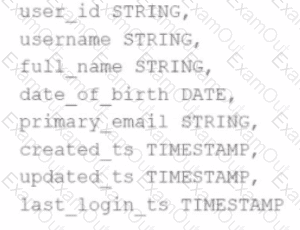A data scientist has identified that some records in the user profile table contain null values in any of the fields, and such records should be removed from the dataset before processing. The schema includes fields like user_id, username, date_of_birth, created_ts, etc.
The schema of the user profile table looks like this:

Which block of Spark code can be used to achieve this requirement?
Options:
A Spark developer is building an app to monitor task performance. They need to track the maximum task processing time per worker node and consolidate it on the driver for analysis.
Which technique should be used?
A data analyst builds a Spark application to analyze finance data and performs the following operations:filter,select,groupBy, andcoalesce.
Which operation results in a shuffle?
A data scientist is working with a Spark DataFrame called customerDF that contains customer information.The DataFrame has a column named email with customer email addresses. The data scientist needs to split this column into username and domain parts.
Which code snippet splits the email column into username and domain columns?
A Spark DataFramedfis cached using theMEMORY_AND_DISKstorage level, but the DataFrame is too large to fit entirely in memory.
What is the likely behavior when Spark runs out of memory to store the DataFrame?

